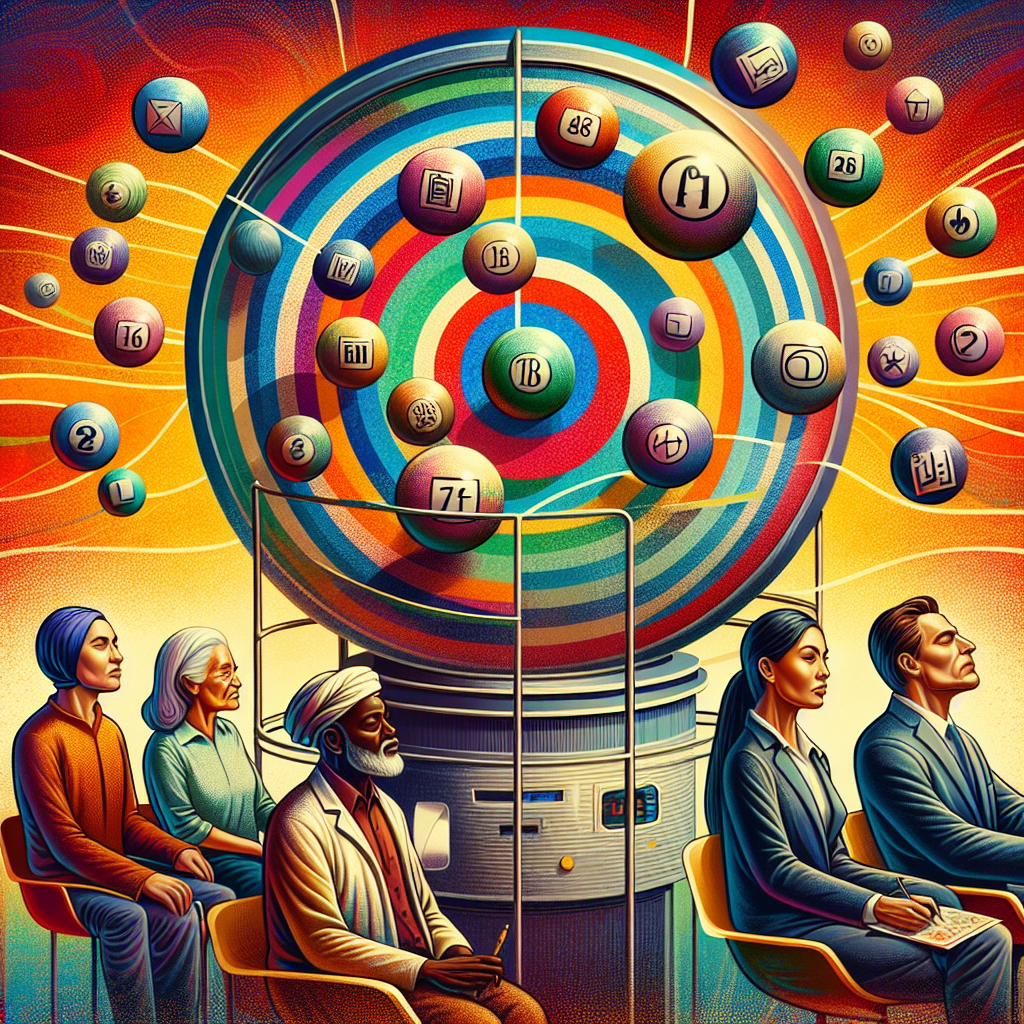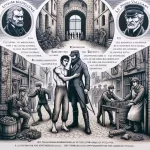-
Table of Contents
“Unveiling Tradition’s Dark Side: A Gripping Exploration of Conformity and Human Nature in ‘The Lottery’.”
“The Lottery” is a short story by Shirley Jackson that explores the dark side of human nature and societal traditions. Set in a small, seemingly idyllic town, the narrative unfolds as the townspeople gather for an annual lottery, which initially appears to be a benign event. However, as the story progresses, it becomes clear that the lottery culminates in a shocking and brutal ritual. Key themes include the dangers of conformity, the impact of tradition, and the capacity for violence within ordinary people. The characters, including Tessie Hutchinson, who becomes the story’s tragic focal point, embody the complexities of human behavior and the chilling effects of blindly following societal norms. Through its unsettling conclusion, “The Lottery” serves as a powerful commentary on the potential for cruelty that lies beneath the surface of community life.
Overview of The Lottery Plot
“The Lottery,” a short story by Shirley Jackson, unfolds in a seemingly idyllic small town that is characterized by its quaint charm and close-knit community. The narrative begins on a warm summer day, with townspeople gathering in the square for an annual event known as the lottery. As the story progresses, the atmosphere is initially one of excitement and anticipation, with children playing and adults engaging in casual conversation. This setting establishes a sense of normalcy, which is crucial for the shocking turn of events that follows.
As the lottery commences, the townspeople participate in a ritual that has been passed down through generations. The lottery involves drawing slips of paper from a black box, a symbol of tradition and the town’s adherence to customs. The box itself is old and worn, reflecting the weight of history and the unquestioned nature of the lottery. The townspeople, including families and friends, display a mix of nervousness and eagerness, which hints at the underlying tension of the event. The reader is gradually introduced to key characters, such as Tessie Hutchinson, who arrives late and jokingly complains about the lottery, unaware of the grim fate that awaits her.
As the drawing progresses, the mood shifts from lightheartedness to unease. The first round of the lottery determines which family will be selected, and the Hutchinson family is chosen. The tension escalates as the townspeople prepare for the final draw, and Tessie becomes increasingly anxious. Her protests and pleas for fairness highlight the arbitrary nature of the lottery and the blind adherence to tradition that the townspeople exhibit. This moment serves as a critical turning point in the narrative, as the reader begins to grasp the true horror of the lottery.
In the final moments of the story, the last slip of paper is drawn, revealing that Tessie Hutchinson has been selected as the “winner.” The shocking revelation that the lottery culminates in a brutal stoning by the townspeople underscores the story’s central themes of conformity, tradition, and the dark side of human nature. The community’s willingness to sacrifice one of their own for the sake of maintaining a ritual raises profound questions about morality and the consequences of blind obedience. Tessie’s desperate cries for mercy are met with indifference, illustrating the chilling reality of how societal norms can dehumanize individuals.
Ultimately, “The Lottery” serves as a powerful commentary on the dangers of unexamined traditions and the capacity for violence that lies within ordinary people. The story’s conclusion leaves readers with a haunting sense of unease, prompting reflection on the nature of humanity and the societal structures that govern behavior. Through its masterful use of irony and symbolism, Jackson crafts a narrative that resonates with contemporary issues, making “The Lottery” a timeless exploration of the complexities of human nature and the often unsettling realities of communal life. The juxtaposition of the ordinary setting with the horrific outcome creates a lasting impact, ensuring that the story remains a poignant reminder of the potential for darkness that exists within us all.
Major Themes in The Lottery
In Shirley Jackson’s short story “The Lottery,” several major themes emerge, each contributing to the narrative’s unsettling atmosphere and profound commentary on human nature and societal norms. One of the most prominent themes is the concept of tradition and its often unquestioned nature. The story unfolds in a small town where the annual lottery is a long-standing ritual, deeply ingrained in the community’s culture. As the narrative progresses, it becomes evident that the townspeople participate in this event without fully understanding its origins or questioning its morality. This blind adherence to tradition raises critical questions about the dangers of conformity and the potential for violence that can arise when individuals fail to challenge societal norms.
Moreover, the theme of violence is intricately woven into the fabric of the story. The lottery, which initially appears to be a benign event, culminates in a shocking act of brutality. This juxtaposition between the ordinary setting and the horrific conclusion serves to highlight the capacity for violence that exists within human beings. Jackson’s portrayal of the townspeople, who are depicted as ordinary individuals, underscores the idea that anyone is capable of committing acts of cruelty when influenced by societal pressures. This theme invites readers to reflect on the darker aspects of human nature and the potential for evil that can manifest in seemingly civilized societies.
Another significant theme in “The Lottery” is the role of scapegoating in human communities. The lottery serves as a mechanism for the townspeople to channel their fears and frustrations onto a single individual, thereby reinforcing social cohesion at the expense of an innocent life. This ritualistic sacrifice reflects a broader commentary on how societies often seek to blame and punish individuals for collective anxieties. The character of Tessie Hutchinson, who becomes the target of the lottery’s violence, embodies the arbitrary nature of scapegoating. Her initial participation in the lottery, followed by her desperate pleas for mercy, illustrates the tragic consequences of a system that prioritizes tradition over compassion.
Additionally, the theme of social class and inequality is subtly interwoven throughout the narrative. The lottery’s outcome is not determined by merit or individual worth but rather by chance, yet the social dynamics within the town reveal underlying tensions. The villagers’ interactions and the way they regard one another hint at a hierarchy that influences their behavior during the lottery. This theme prompts readers to consider how social structures can perpetuate injustice and how individuals may be complicit in systems that devalue human life.
In conclusion, “The Lottery” serves as a powerful exploration of themes such as tradition, violence, scapegoating, and social inequality. Through the lens of a seemingly innocuous community event, Shirley Jackson challenges readers to confront the darker aspects of human nature and the societal constructs that can lead to moral blindness. The story’s chilling conclusion leaves a lasting impression, compelling readers to reflect on the implications of conformity and the potential for cruelty that lies within us all. Ultimately, Jackson’s work remains a poignant reminder of the importance of questioning traditions and recognizing the humanity in others, urging a critical examination of the values that govern our lives.
Character Analysis of Tessie Hutchinson
In Shirley Jackson’s short story “The Lottery,” Tessie Hutchinson emerges as a complex character whose evolution throughout the narrative serves as a critical lens through which the themes of tradition, conformity, and the arbitrary nature of violence are explored. Initially introduced as a seemingly carefree participant in the annual lottery, Tessie’s character quickly transforms as the story unfolds, revealing deeper layers of societal critique and personal tragedy.
At the beginning of the story, Tessie appears to embody the typical small-town citizen, arriving late to the lottery with a light-hearted demeanor. Her jovial banter with other villagers, including her husband, Bill Hutchinson, suggests a sense of normalcy and acceptance of the ritual that governs their community. However, this initial portrayal is deceptive, as it masks the underlying tension and dread associated with the lottery. Tessie’s casual attitude reflects the complacency of the townspeople, who have blindly adhered to a tradition that ultimately leads to violence. This juxtaposition between her light-heartedness and the grim reality of the lottery foreshadows her eventual fate and highlights the theme of conformity, as Tessie, like her neighbors, has internalized the societal norms that dictate their actions.
As the lottery progresses, Tessie’s character begins to shift dramatically. When her family is selected, her initial reaction is one of disbelief and protest. She exclaims that it is unfair, a sentiment that starkly contrasts with her earlier acceptance of the lottery’s inevitability. This moment marks a pivotal turning point in Tessie’s character arc, as she transitions from a passive participant to an active challenger of the tradition. Her desperate pleas for fairness reveal her instinct for self-preservation and her growing awareness of the arbitrary nature of the lottery. In this sense, Tessie becomes a symbol of the individual against the collective, embodying the struggle to assert one’s humanity in the face of societal brutality.
Moreover, Tessie’s character serves to illuminate the theme of scapegoating inherent in the lottery. As the villagers turn against her, Tessie’s isolation becomes palpable. Her frantic attempts to argue for her life are met with indifference and hostility from her neighbors, who have been conditioned to view the lottery as a necessary evil. This transformation from a community member to a target underscores the chilling reality of how societal norms can dehumanize individuals, reducing them to mere objects of sacrifice. Tessie’s fate ultimately serves as a critique of blind adherence to tradition, illustrating how easily individuals can become complicit in violence when they prioritize conformity over compassion.
In the final moments of the story, Tessie’s desperate cries for mercy resonate with a haunting clarity, encapsulating the tragic irony of her situation. The very community she once belonged to now turns against her, revealing the fragility of social bonds when confronted with the demands of tradition. Tessie’s character, therefore, not only highlights the personal tragedy of her demise but also serves as a broader commentary on the dangers of unexamined customs and the potential for cruelty that lies within human nature.
In conclusion, Tessie Hutchinson’s character in “The Lottery” is a poignant exploration of the themes of conformity, tradition, and the arbitrary nature of violence. Her transformation from a carefree participant to a desperate victim underscores the story’s critique of societal norms and the chilling consequences of blind adherence to tradition. Through Tessie’s tragic fate, Jackson compels readers to reflect on the moral implications of their own societal practices and the potential for violence that can arise when individuals prioritize conformity over empathy.
The Role of Tradition in The Lottery
In Shirley Jackson’s short story “The Lottery,” tradition plays a pivotal role in shaping the community’s actions and beliefs, ultimately leading to a chilling conclusion. The narrative unfolds in a seemingly idyllic village, where the annual lottery is a long-standing custom that the townspeople participate in without question. This adherence to tradition is emblematic of how societal norms can dictate behavior, often without critical examination. As the story progresses, it becomes evident that the lottery, which culminates in a brutal act of violence, is a ritual steeped in historical significance, yet devoid of rational justification.
The villagers’ unwavering commitment to the lottery illustrates the power of tradition to influence collective behavior. Despite the absence of a clear rationale for the lottery’s continuation, the townspeople engage in the ritual with a sense of obligation. This blind adherence is particularly evident in the character of Old Man Warner, who represents the voice of tradition and warns against abandoning the lottery. His insistence that “there’s always been a lottery” underscores the idea that tradition can become an end in itself, often perpetuated by fear of change and the unknown. This perspective highlights how traditions can become entrenched, leading individuals to prioritize conformity over morality.
Moreover, the story reveals the dangers inherent in unexamined traditions. The villagers, including the seemingly progressive characters like Tessie Hutchinson, initially accept the lottery as a normal part of life. However, as the narrative unfolds, it becomes clear that this acceptance masks a deeper complicity in violence and cruelty. The ritualistic nature of the lottery serves as a commentary on how societies can normalize barbaric practices under the guise of tradition. The chilling climax, where Tessie becomes the victim of the lottery, starkly illustrates the consequences of blind adherence to customs that lack ethical justification.
In addition to highlighting the dangers of tradition, Jackson’s story also explores the theme of community complicity. The villagers’ collective participation in the lottery reflects a societal dynamic where individuals prioritize group cohesion over personal morality. This phenomenon is particularly evident in the way the townspeople turn on Tessie, who, moments before, was an integral part of the community. The swift transition from camaraderie to violence underscores how tradition can erode individual empathy, transforming neighbors into participants in a horrific act. This shift serves as a powerful reminder of how societal pressures can lead individuals to act against their better judgment.
Furthermore, the story raises questions about the role of tradition in shaping identity and belonging. For many characters, participating in the lottery is a means of affirming their place within the community. The fear of ostracism or being labeled as an outsider compels individuals to conform to the ritual, even when it contradicts their moral compass. This dynamic illustrates how traditions can create a sense of belonging, albeit at a significant ethical cost.
In conclusion, “The Lottery” serves as a profound exploration of the role of tradition in human behavior. Through the lens of a seemingly innocuous village ritual, Jackson critiques the dangers of unexamined customs and the potential for violence that lies within societal norms. The story compels readers to reflect on the traditions they uphold and the moral implications of their adherence, ultimately questioning whether the preservation of tradition is worth the sacrifice of individual conscience and humanity.
Symbolism in The Lottery
In Shirley Jackson’s short story “The Lottery,” symbolism plays a crucial role in conveying the underlying themes and enhancing the narrative’s impact. At first glance, the story presents a seemingly idyllic small-town setting, where the annual lottery is a tradition that the townspeople eagerly anticipate. However, as the plot unfolds, the symbols embedded within the narrative reveal a darker commentary on human nature and societal norms. One of the most prominent symbols in the story is the lottery itself, which represents the blind adherence to tradition. The townspeople participate in the lottery without questioning its purpose or morality, illustrating how societal customs can perpetuate violence and cruelty. This blind acceptance of tradition serves as a critique of conformity, suggesting that individuals often prioritize societal expectations over ethical considerations.
Another significant symbol is the black box used for the lottery. The box, worn and splintered, symbolizes the outdated and decaying nature of the tradition it represents. Despite its dilapidated state, the townspeople are reluctant to replace it, reflecting their unwillingness to challenge or change the status quo. This attachment to the black box signifies how people can become emotionally invested in rituals, even when those rituals are harmful. The box’s color, black, further emphasizes the ominous nature of the lottery, as black is often associated with death and mourning. This symbolism foreshadows the grim outcome of the lottery, highlighting the juxtaposition between the townspeople’s cheerful demeanor and the horrific reality of their actions.
Moreover, the stones used by the townspeople to carry out the lottery’s violent conclusion serve as a powerful symbol of communal complicity in violence. The act of stoning is not only a method of execution but also a representation of how society can collectively participate in acts of brutality. The townspeople’s willingness to turn on one of their own, particularly Tessie Hutchinson, underscores the theme of scapegoating, where an individual is sacrificed for the perceived benefit of the community. This ritualistic violence raises questions about morality and the human capacity for cruelty, suggesting that individuals can become desensitized to violence when it is normalized within a societal framework.
Additionally, the character of Tessie Hutchinson embodies the tragic consequences of blind tradition. Initially, she appears to be a typical participant, but as the lottery progresses, her fate becomes a poignant symbol of the arbitrary nature of victimization. Tessie’s desperate protests against the unfairness of the lottery highlight the theme of individual versus society, illustrating how one person’s voice can be drowned out by the collective will of the community. Her eventual fate serves as a chilling reminder of the dangers of conformity and the ease with which individuals can become complicit in acts of violence.
In conclusion, the symbolism in “The Lottery” enriches the narrative and deepens its exploration of themes such as tradition, violence, and the human condition. Through the lottery itself, the black box, and the stones, Jackson critiques the dangers of blind adherence to societal norms and the potential for cruelty that lies within human nature. The story serves as a powerful reminder of the importance of questioning traditions and the moral implications of our actions within a community. Ultimately, “The Lottery” challenges readers to reflect on their own societal practices and the potential consequences of conformity.
The Impact of Setting on The Lottery
In Shirley Jackson’s short story “The Lottery,” the setting plays a crucial role in shaping the narrative and enhancing its themes. The story unfolds in a small, seemingly idyllic village, characterized by its quaint charm and the familiarity of its residents. This setting, with its picturesque description of a sunny day and the gathering of townspeople, creates an initial sense of normalcy and community. However, as the plot progresses, the stark contrast between the setting and the story’s dark conclusion becomes increasingly apparent, underscoring the themes of tradition, conformity, and the potential for violence within society.
The village itself is emblematic of a microcosm where social norms and customs dictate behavior. The annual lottery, a ritualistic event, is deeply embedded in the community’s culture, and the setting serves to reinforce the acceptance of this tradition. The open square, where the townspeople gather, symbolizes a space of communal interaction, yet it also becomes a site of horror as the lottery unfolds. The juxtaposition of the serene environment with the brutal act of violence highlights the dissonance between appearance and reality. This contrast invites readers to reflect on how societal norms can mask underlying brutality, suggesting that even the most peaceful settings can harbor dark secrets.
Moreover, the setting contributes to the story’s exploration of conformity and the human tendency to adhere to tradition without questioning its morality. The villagers, who are portrayed as ordinary individuals, are bound by the customs of their community. The setting, with its familiar landmarks and communal spaces, fosters a sense of belonging that discourages dissent. As the lottery progresses, the characters’ interactions reveal a disturbing willingness to participate in the ritual, driven by the fear of social ostracism. This dynamic illustrates how the setting not only influences individual behavior but also perpetuates a collective mindset that prioritizes tradition over ethical considerations.
Additionally, the time period in which the story is set—an unspecified mid-20th century—further enhances the themes of the narrative. The simplicity of rural life, coupled with the absence of modern distractions, allows for a focus on the community’s rituals. This temporal context emphasizes the idea that traditions can persist unexamined, leading to a blind acceptance of practices that may be harmful. The villagers’ reluctance to question the lottery reflects a broader commentary on societal complacency, suggesting that the setting serves as a breeding ground for unchallenged beliefs and practices.
As the story reaches its climax, the setting transforms from a place of communal gathering to a site of horror. The once-familiar square becomes a stage for violence, illustrating how quickly the veneer of civilization can crumble. The impact of the setting is profound, as it not only frames the events of the story but also amplifies the emotional resonance of the characters’ actions. The chilling conclusion serves as a stark reminder of the potential for cruelty that exists within human nature, often hidden beneath the surface of societal norms.
In conclusion, the setting of “The Lottery” is integral to understanding the story’s themes and character dynamics. Through its depiction of a seemingly ordinary village, Jackson effectively critiques the dangers of conformity and the unexamined acceptance of tradition. The contrast between the tranquil environment and the horrific outcome serves to illuminate the complexities of human behavior, ultimately prompting readers to question the rituals and customs that govern their own lives.
Q&A
1. **What is the main plot of “The Lottery”?**
– “The Lottery” is a short story by Shirley Jackson that depicts a small town’s annual ritual in which residents draw lots to determine who will be stoned to death as a sacrifice to ensure a good harvest.
2. **What is the central theme of “The Lottery”?**
– The central theme is the danger of blindly following tradition without questioning its morality or purpose, highlighting how societal norms can lead to violence and inhumanity.
3. **Who is the protagonist in “The Lottery”?**
– Tessie Hutchinson is the protagonist, who becomes the victim of the lottery when her family draws the marked slip, ultimately challenging the tradition as she protests against the unfairness of the ritual.
4. **What role does symbolism play in “The Lottery”?**
– The lottery itself symbolizes the arbitrary nature of violence and the dark side of human nature, while the black box used for the drawing represents tradition and the resistance to change.
5. **How does the setting influence the story?**
– The story is set in a seemingly idyllic small town, which contrasts sharply with the brutal outcome of the lottery, emphasizing the theme that evil can exist in ordinary places and among ordinary people.
6. **What is the significance of the ending of “The Lottery”?**
– The ending, where Tessie is stoned to death by her friends and family, serves as a shocking commentary on the capacity for cruelty within human beings and the chilling effects of conformity to tradition.In “The Lottery” by Shirley Jackson, the story revolves around a small town’s annual ritual of conducting a lottery that culminates in a shocking and violent outcome. The primary themes include the dangers of blindly following tradition, the randomness of violence, and the dark side of human nature. Key characters such as Tessie Hutchinson, who becomes the victim of the lottery, and the townspeople, who exhibit a chilling acceptance of the ritual, highlight the conflict between individual morality and societal norms. Ultimately, the story serves as a powerful commentary on conformity and the potential for cruelty inherent in human behavior when tradition overrides compassion.




